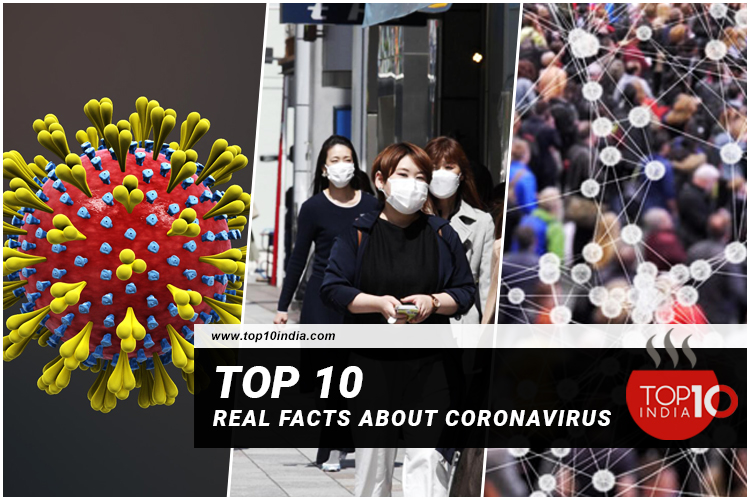Top 10 Real Facts About Coronavirus: It’s been a year since we have been introduced to the COVID – 19 virus. The first instance of this respiratory sickness of this new coronavirus was recorded in Wuhan in Hubei Province, China, in December of 2019. Since then the World Health Organization pronounced a pandemic on March 11, 2020. Here are some important things you need to know about the Top 10 Real Facts About Coronavirus
Top 10 Real Facts About Coronavirus
- The novel coronavirus is called SARS-CoV-2, and the disease is COVID-19.
In term SARS-CoV-2, the acronyms stand for Severe Acute Respiratory Syndrome-Coronavirus-2. A very similar virus to the SARS coronavirus first was discovered back in 2003. The SARS-CoV-2 disease is COVID-19, as the outbreak occurred in 2019.
- The 1stcases in the United States were primarily in people who traveled from China.
The first known cases of COVID-19 in the United States were in people returning from China, cruise ships, and subsequently from other countries with COVID-19 spread. Some people who had no known travel history or close contact with an infected person were also tested positive. These cases are community cases because they did not come from a known source.
- The novel coronavirus spreads very easily from person to person.
Tiny respiratory droplets from the nose and mouth of an infected person when an infected person coughs or sneezes are responsible for the transmission. You are also at the risk of catching the coronavirus if these droplets land in your nose or mouth, you inhale them. Even if you touch a contaminated surface or object and then touch your nose or mouth before washing your hands, you are at risk.
- Social distancing and wearing a mask helps to slow the spread of infection.
You can slow the spread of COVID-19 by going out unnecessarily, social distancing while going out, avoiding large public gatherings, and keeping a distance of 6 feet from other people. You can limit the number of respiratory droplets you release into the environment when you talk, sneeze, and cough by wearing a mask or covering your mouth.
- COVID-19 symptoms range from mild to severe and can be fatal.
Coronavirus symptoms are the same as those of a common cold, while some experience the symptoms of a severe respiratory infection. The primary COVID-19 symptoms include fever, cough, body aches, sore throat, fatigue, phlegm/sputum production, and shortness of breath. Also one of the unusual symptoms is loss of sense of smell. The virus attacks the lungs in some cases, and the patient may require hospitalization with oxygen support, fluids, and even breathing support with a ventilator. The symptoms appear within 2 to 14 days after exposure.
- The FDA certified the first targeted COVID-19 treatment.
The Food and Drug Administration lately approved the drug, Remdesivir for the COVID-19 patients who are hospitalized. This drug isn’t specific for this variant of the virus but has shown promising clinical results. The first treatment of covid-19 is known as Bamlanivimab. It is a monoclonal antibody, which the FDA suggests for patients having mild to severe symptoms.
- There are three authorized COVID-19 vaccines.
At the end of 2020, 2 vaccines of covid were approved and certified by the FDA for emergency or immediate use. In Feb 2021 FDA approved 3rd vaccine. It is seen that the three vaccines are highly effective in preventing COVID-19. The vaccines from Moderna and Johnson & Johnson are authorized for people above 18 years of age. Huge vaccination drives are being conducted in 2021 across the world.
- The source of the novel coronavirus is linked to animals.
Patients in Wuhan, China, were connected to a huge fish and exotic animals market. Once it infected humans, the infection had the option to spread from individual to individual. This is similar to the spread of two other Covid viruses that started from creatures: SARS-CoV (civet felines) and MERS-CoV (camels).
- The novel coronavirus is mutating.
Various mutations can be seen in the coronavirus consistently, as different individuals have different symptoms. This is typical for covid viruses and numerous other infections. Mostly, the changes have little impact. In other cases, they can have a sensational impact, similar to the variation originally found in the United Kingdom. The U.K., or B.1.1.7 variation, spreads 30 to 50 percent faster than the first infection and causes more serious sickness. B1.1.7 is the most widely recognized offspring of new U.S. Coronavirus cases.
- Get tested for COVID-19 if you have signs or symptoms.
If you feel any symptoms of COVID-19, contact your primary health care center. There is an incubation period for the infection. Regardless of whether you get infected, your COVID test report will be negative until you have sufficient infection to be distinguished.
Conclusion:
Staying home and avoiding close contact with people is the only known and proven solution to avoid the risk of getting infected.
FAQ’S
- Can you have COVID-19 without a fever?
Yes, A fever higher than 100.4°Fis a common symptom of COVID-19.
- Can the COVID-19 survive in drinking water?
There is no evidence supporting the survival of the COVID-19 virus in drinking water or sewage.
- How many people have died from Covid-19?
As of today, 3,214,706 people have died so far from the coronavirus. Cases are confirmed in over 220 countries.
- How long can COVID-19 survive on surfaces?
Coronavirus can survive on surfaces for several hours to days after coming from the infected person’s body.























Be First to Comment